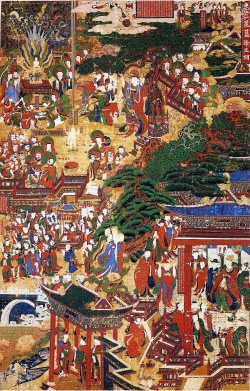Difference between revisions of "(Sick/dead man)--The world outside the palace"
| Line 1: | Line 1: | ||
[[File:2sang.jpg|thumb|250px|]] | [[File:2sang.jpg|thumb|250px|]] | ||
| + | <poem> | ||
(Sick/dead man)--The [[world]] outside the palace | (Sick/dead man)--The [[world]] outside the palace | ||
| − | Eventually [[Siddhartha]] began to see, out-side the [[sanctuary]] of the palace, [[sickness]], [[old age]] and [[death]]. Then he saw a [[recluse]] and [[realized]] that the only way to overcome [[sickness]], [[old age]] and [[death]] was to leave home and attain | + | |
| + | Eventually [[Siddhartha]] began to see, out-side the [[sanctuary]] of the palace, [[sickness]], [[old age]] and [[death]]. Then he saw a [[recluse]] and [[realized]] that the only way to overcome [[sickness]], [[old age]] and [[death]] was to leave home and attain [[enlightenment]]. [[Siddhartha]] decided to leave his family and home for [[solitude]] and [[meditation]]. | ||
| + | |||
In the simple pictures one emaciated [[body]] tells the story. In the complex ones, [[life]] goes on as usual in the palace, but outside the walls in the lower right can be seen {{Wiki|illness}} and in the lower left, [[death]]. | In the simple pictures one emaciated [[body]] tells the story. In the complex ones, [[life]] goes on as usual in the palace, but outside the walls in the lower right can be seen {{Wiki|illness}} and in the lower left, [[death]]. | ||
(White [[horse]] over wall)--Renunciation | (White [[horse]] over wall)--Renunciation | ||
| + | |||
His father, {{Wiki|learning}} of Siddhartha췷 {{Wiki|intentions}} to leave the palace, placed extra guards by the gates and others to watch over his son at all times. | His father, {{Wiki|learning}} of Siddhartha췷 {{Wiki|intentions}} to leave the palace, placed extra guards by the gates and others to watch over his son at all times. | ||
But [[Siddhartha]], with the aid of the [[four guardians]] and other [[spirits]], was able to escape over the wall on his favorite white [[horse]]. | But [[Siddhartha]], with the aid of the [[four guardians]] and other [[spirits]], was able to escape over the wall on his favorite white [[horse]]. | ||
A white [[horse]] taking to the [[air]], with his [[master]] astride it and the groom hanging on to the tail, represents [[renunciation]]. | A white [[horse]] taking to the [[air]], with his [[master]] astride it and the groom hanging on to the tail, represents [[renunciation]]. | ||
| + | </poem> | ||
{{R}} | {{R}} | ||
[http://www.buddhism.org/board/read.cgi?board=glossary&nnew=2&y_number=34 www.buddhism.org] | [http://www.buddhism.org/board/read.cgi?board=glossary&nnew=2&y_number=34 www.buddhism.org] | ||
[[Category:Buddhist Terms]] | [[Category:Buddhist Terms]] | ||
[[Category:Eight scenes of the life of Buddha]] | [[Category:Eight scenes of the life of Buddha]] | ||
Revision as of 05:45, 6 February 2015
(Sick/dead man)--The world outside the palace
Eventually Siddhartha began to see, out-side the sanctuary of the palace, sickness, old age and death. Then he saw a recluse and realized that the only way to overcome sickness, old age and death was to leave home and attain enlightenment. Siddhartha decided to leave his family and home for solitude and meditation.
In the simple pictures one emaciated body tells the story. In the complex ones, life goes on as usual in the palace, but outside the walls in the lower right can be seen illness and in the lower left, death.
(White horse over wall)--Renunciation
His father, learning of Siddhartha췷 intentions to leave the palace, placed extra guards by the gates and others to watch over his son at all times.
But Siddhartha, with the aid of the four guardians and other spirits, was able to escape over the wall on his favorite white horse.
A white horse taking to the air, with his master astride it and the groom hanging on to the tail, represents renunciation.
